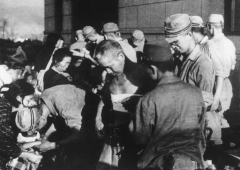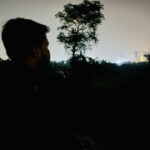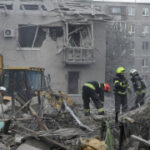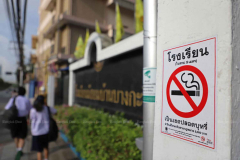She was only seven years old at the time, but Michiko Kodama has a crystal-clear memory of the morning of August 6, 1945 in Hiroshima, Japan.
“It was a sunny day,” she says. “At 8: 15, I was at school, sitting at my desk at the front of the class, when there was a tremendous white flash and the ceiling collapsed. A piece of glass was lodged in my shoulder, and all around me people were trapped by pieces of debris, but somehow everybody was still alive.”
The next thing she remembers is being in the school clinic where one of the teachers removed the glass. “They tore up curtains to clean our wounds as best they could. Then my father arrived. He put me on his back and we walked home together.”

Michiko is a “hibakusha” or “bomb-affected person” – a survivor of the nuclear bombs dropped by the United States on the Japanese cities of Hiroshima and Nagasaki. The hibakusha, including the descendants of those who experienced the bombings, today number about 540,000.
Nearly nine decades since those horrific events, Nihon Hidankyo, the organisation representing hibakusha, was awarded the Nobel Peace Prize on October 11, 2024 “for its efforts to achieve a world free of nuclear weapons and for demonstrating through witness testimony that nuclear weapons must never be used again”, in the words of the Nobel Foundation.
Nihon Hidankyo was established in 1956 to raise public awareness across the world by showcasing, through the experiences of hibakusha, the apparent long-term effects of nuclear weapons. These include leukaemia, cancer and psychological trauma which, according to Nihon Hidankyo, have affected second and even third generations.
The Radiation Effects Research Foundation (a research institute jointly funded by the governments of Japan and the US) continues to collect data up to this very day – but has yet to acknowledge any unusual health effect upon the offspring or grandchildren of atomic bomb survivors. It remains a highly complex scientific topic, with numerous academic studies coming to different conclusions.
Michiko stands with Nihon Hidankyo’s version of events, and no story illustrates this more vividly than her own. Cheerful, friendly and optimistic, Michiko is neatly dressed and diminutive, with an elegant short hairstyle – an energetic member of Nihon Hidankyo even in her eighties. Her conversation is frequently punctuated by soft laughter, as she finds moments of humour even when relating her darkest hours.

‘I cannot forget the scenes I witnessed’
Michiko was born near Hiroshima in 1938, the eldest child of a well-to-do family in the publishing business. As the Second World War dragged on, with US forces advancing across the Pacific towards Japan, she and her family lived in the Hiroshima suburb of Takasu.
While towns and cities across Japan were being carpet-bombed, Hiroshima and Nagasaki remained pristine up to August 6 – but only because the US was planning to measure the precise damage of a nuclear weapon in those cities, a fact openly revealed by Manhattan Project director Leslie Groves in his 1962 book, Now it Can be Told: The Story of the Manhattan Project.
As Michiko was carried home by her father just hours after the bombing, the things she saw were imprinted in her memory for the rest of her life.
“Even after 79 years I cannot forget the scenes I witnessed: a terribly burned mother cradling the charred remains of her baby; people without eyes, crawling around aimlessly; others staggering along, holding their intestines in their hands.”
Later on, Michiko learned that her neighbourhood of Takasu – located about 3.5km (2 miles) from the hypocentre (directly beneath the bomb) – had experienced the heaviest downfall of nuclear-contaminated “black rain”: a toxic mix of ash, water and radioactive waste. Nihon Hidankyo later contended that the black rain caused diseases such as anaemia and leukaemia. The organisation achieved a victory in 2021 when the Hiroshima High Court ruled that people exposed to the black rain outside the boundaries of the area directly hit by the bomb should also be officially classified as hibakusha as they had experienced similar health problems.

Michiko explains how the tight family unit that remains a common feature of Japanese society was the only means of survival for so many in the aftermath of the nuclear bombing. Her family house was only partially destroyed and became a haven for dozens of injured and homeless relatives.
“A number of our relatives began to arrive, escaping from the worst-hit areas,” she recalls. “Many of them were severely injured, with their skin and flesh peeled off.”
With electricity, gas and running water all cut off, and no access to medical supplies, the family struggled to make do. “But we did have a well in our back yard, and were able to use that fresh spring water to clean the wounds and quench the thirst of the wounded,” Michiko says.
Mercifully, none of her immediate family – her parents, her younger brother Hidenori and her younger sister Yukiko – were killed or even badly injured in the attack, but in the following days and weeks she saw terribly wounded relatives passing away one by one, including a favourite girl cousin, aged 14, who died in Michiko’s arms from her severe burns.
Life went on, however. Within a week, Hiroshima began to return to some semblance of normality. Some rail lines remained intact, allowing trains to wind their way through the blackened remnants of the city. Vendors set up shop again in their ruined premises.
Meanwhile, Nagasaki was bombed on August 9. It is impossible to know the true number of casualties as a direct result of the nuclear attacks, because there was no census in wartime Japan. The US military estimated 70,000 had been killed in Hiroshima (from a population of about 255,000) and 40,000 in Nagasaki (from some 195,000); however, the Bulletin of the Atomic Scientists, a US nonprofit group founded by Albert Einstein, which advocates against nuclear weapons, estimates the numbers were closer to 140,000 in Hiroshima and 70,000 in Nagasaki. The total population of Japan in 1945 was about 71 million.

Roasting grasshoppers to survive
On August 15, Emperor Hirohito made a radio broadcast announcing the unconditional surrender of Japan, bringing to an end 15 years of war, first with China and then the western Allies.
“It took quite a long time until our life began to feel stable again,” Michiko says. “Having been relatively wealthy, it was now difficult for my parents even to secure enough food to eat. My little brother Hidenori and I would go out to catch grasshoppers which we’d roast in a pan – that might sound cruel but it was a source of protein. We would also go to a nearby river to catch shellfish,” she recalls.
Michiko’s mother had been pregnant at the time of the atomic bombing. Her youngest brother was born a few months later but he died shortly afterwards – almost certainly due to radiation poisoning, Michiko contends.
Some 120,000 hibakusha died of burn and radiation injuries in the aftermath of the attacks, according to Nihon Hidankyo. So-called “radiation sickness” included symptoms such as internal haemorrhaging, vomiting, inflammation of the mouth and throat, diarrhoea and high fever.






